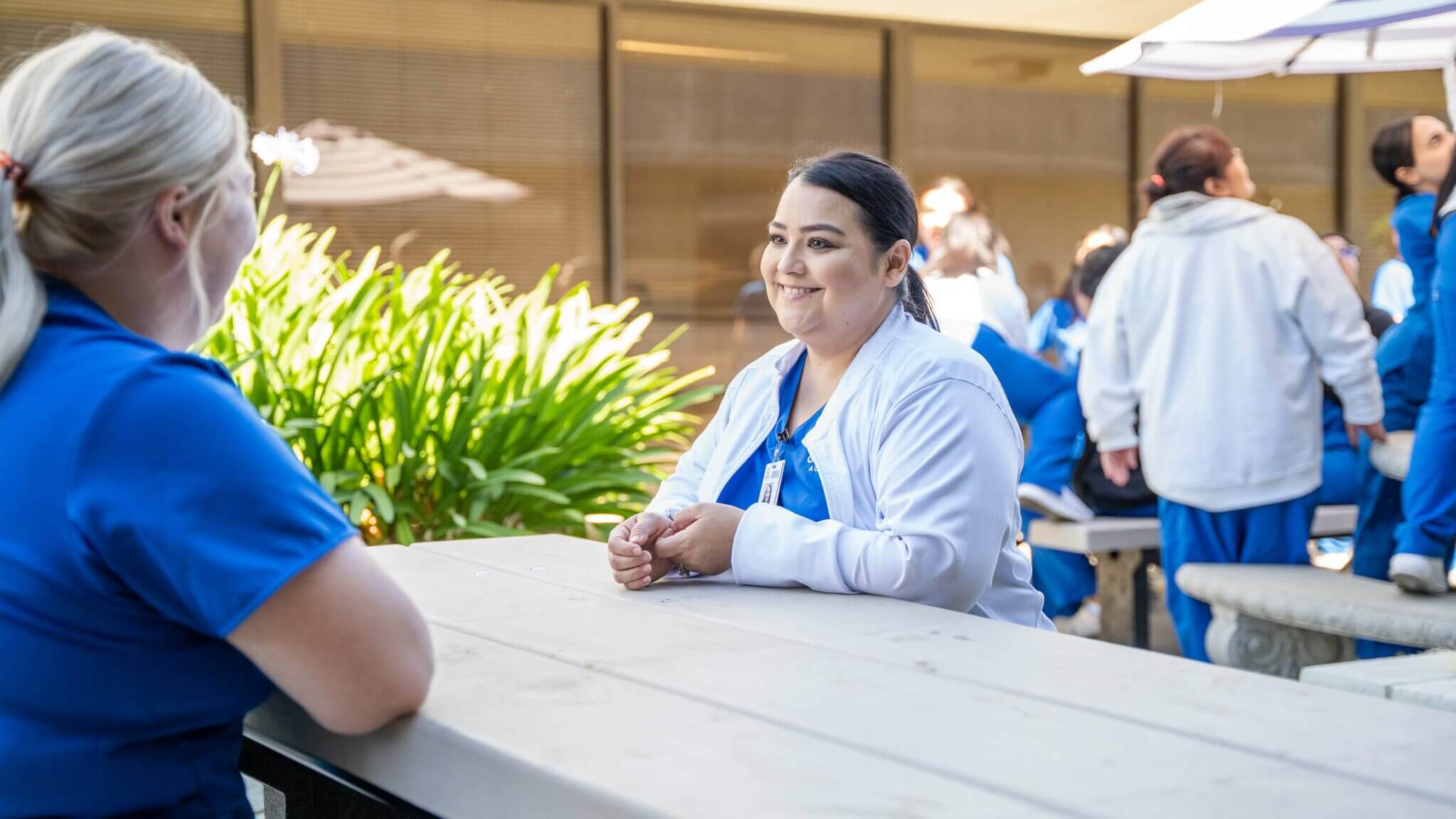Who’s the Person Behind the Desk? CNA Versus MA
Date: November 15, 2022
If you look for the letters “LPN” or “RN” on the badge of the friendly person taking your vitals at your last doctor’s visit, they might have been missing. Likewise, the cheery person behind the front desk billing your insurance might not have had those letters either. Who was this person?
Nurses and physicians rely increasingly on medical support individuals to carry out wellness operations. Two typical auxiliary roles, relieving duties and making up modern healthcare environments, include Certified Nursing Assistants (CNAs) and Medical Assistants (MAs).
Categorically Trained
Equally important, CNAs and MAs are trained categorically to carry out similar functions. However, even with much in common, there are significant distinctions. This article doesn’t attempt to bring back the nurse that “did it all.” Instead, it seeks to compare and contrast the two roles and explain what the letters on their badges might mean. 🙂
What’s a CNA? What’s an MA?
Foremost, both CNAs and MAs are essential healthcare professionals. Additionally, each may work in a variety of similar wellness settings.1 Ample opportunity for both may be found in hospitals, clinics, private practices, nursing homes, assisted living, and retirement communities.
Additionally, CNAs and MAs directly interact with patients and healthcare teams. Correspondingly, both vocations require training and education, whether formal or informal. Likewise, each professional can take your vitals, fulfill requests, and relay your needs to your medical team.
Key Differences
But, before your mind “assigns” them the same credentials, know there are some significant differences. While neither is licensed,2 CNAs must be certified.3 By contrast, MAs don’t necessarily have to hold the certification.4 Instead, “MAs generally work under the licenses of their supervising physicians or the managed care organizations that employ them.”5
Although, in practicality, MAs may be certified within their places of work due to insurance mandates. Additionally, some MAs seek certification as requisites to move into advanced specialties.
Other items not in lockstep for the two vocations (or in determining who gets which badge) include
1) Versatility,
2) Scopes of Practice,
3) Opportunities to Specialize,
4) Salaries.
Versatility
The first key difference is in the versatility and focus of their roles. CNAs predominantly provide caregiving functions strictly, while MAs are cross-trained to conduct administrative and clinical responsibilities.”6 Where CNAs focus almost entirely on bedside functions, MAs extend their focus beyond these into administrative tasks.
Termed front-office or back-office: administrative or clinical, an MA’s role can range from classic office functions such as greeting patients and sending appointment reminders. Or an MA may be clinical, such as taking a patient’s blood. But the real game changer is an MA role can be AND + OR. Consequently, while some MAs singularly work in one area, others form a hybrid–performing duties dually.
 Varying Duties
Varying Duties
For the above reason, MAs are sometimes called the most versatile allied health professionals. A workday might mean processing medical bills or negotiating with insurance companies. Or it could mean acting as a part medical liaison, facilitating communications between a doctor and patient. Moreover, the MA vocation may be strictly operational such as verifying prescriptions at a local pharmacy or completing electronic medical charts.
Then again, it could mean triaging patients over the “telephone using a protocol to determine the acuity of the visit and the visit length for scheduling purposes.”5 Still, an MA might assist with surgical procedures such as removing sutures or changing dressings.5
Scopes of Practice
Second, CNAs and MAs differ in their scopes of practice. “Traditionally, the CNA role was divided into three C’s, ‘namely the provision of Care, Comfort and Communication,’ says AMN Healthcare Education Services.”7 Aids must have many soft skills and be kind, patient, and calm with superb bedside manners.
CNAs
Overall, “CNAs are trained to perform direct services related to daily living activities. A CNA might provide bed baths or showers, help patients with toileting activities, feed patients, or collect specimens.”9 Likewise, the top tools used by CNAs reflect caregiving tasks wholly. According to O*NET, these include electronic stethoscopes, gait belts, glucose monitors, automated external defibrillators (AED), shower and bath chairs, therapeutic heating or cooling pads, and wheelchairs.12
Chiefly CNAs must work under the direction of either nurses or physicians. Because these people assist patients routinely, aids often find work within nursing homes.9
To learn more about a CNA’s scope of practice, click here.)3
MAs
On the other hand, an MA’s responsibilities can be molded around an institution’s needs or tailored to patient flow, such as to “handle a wide range of tasks that would otherwise be performed by receptionists, practice managers, nurses, and physicians.”5 For this reason, MAs predominately work in physicians’ offices.
Under certain conditions and training, an MA may also provide medications and perform advanced tasks. Pending state laws, specific protocols, orders, supervision, and directions, “MAs might perform procedures such as urinalysis, strep tests, blood pressure checks, weight checks, electrocardiograms, venipuncture, and injections.”5
To learn more about an MA’s scope of practice, click here.)10
Opportunities to Specialize
A third difference between CNAs and MAs* is their option to specialize. MAs may choose from an array of advancement areas. For example, some MAs provide eye care at optometrists’ offices or assist gynecologists/obstetricians. Others specialize as cardiology technicians or work at orthopedic clinics, greeting and escorting patients.†8
How Does an MA Specialize?
Generally, an MA may specialize by finding a niche area and gaining advanced training directly. A standard route to specialty is to:
a) Complete training as an MA;
b) Earn credentialing through a specific medical specialty. For example, if one seeks to be a podiatric MA, they might complete MA training, then go on to seek credentials through the American Society of Podiatric Medical Assistants.11
Salaries
The fourth significant dissimilarity between CNAs and MAs is their compensation. According to the Bureau of Labor and Statistics, this difference looks like the following:
CNA Wages in California: CNAs in this state annually earn, on average, $37,450.13
CNA Wages in the US: CNAs nationwide annually earn, on average, $30,310.13
MA Wages in California: MAs in this state annually earn, on average, $44,780.14
MA Wages in the US: MAs nationwide annually earn, on average, $38,190.14
Summary
Neither profession is “better than the other;” however, an MA trajectory may provide more personal options. Additionally, an MA route might give one more variety because their role can be ever-changing and cover different domains. Moreover, an MA pathway may allow one to move into specific areas of interest. Both professional roles seek to help people—and that’s always a good thing.
So, the next time you’re at the doctor’s office, see if you can spot an MA without even looking at their badge. If they have a clipboard in one hand, a stethoscope in the other, and know how to bill their insurance while talking about going into a specialty, they might just be an MA! Check out our MA course today. ~
*MAs should not be confused with physician assistants. Physician assistants examine, diagnose, and treat patients collaboratively with a physician, who may or may not be on-site.”3
†Medical assistant specializations require additional certification.







